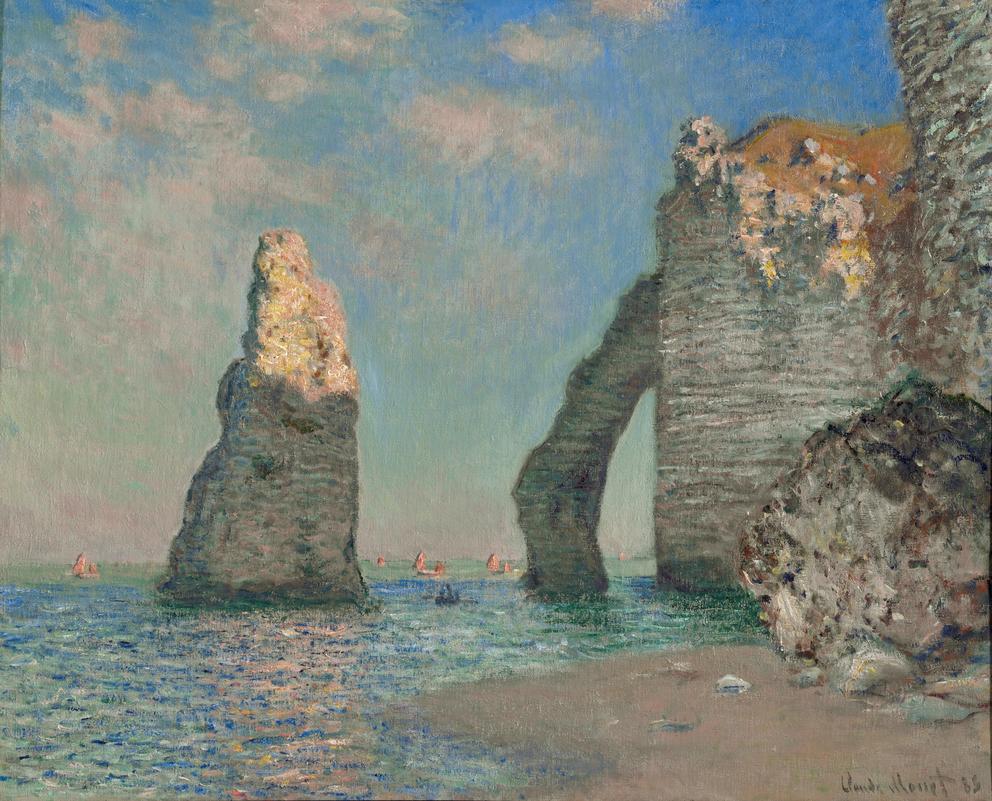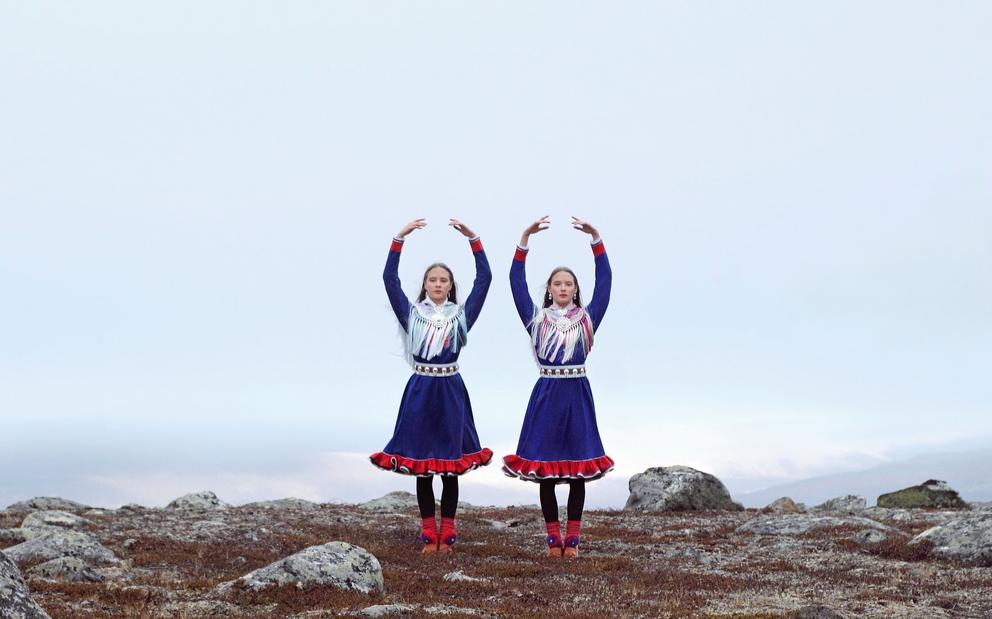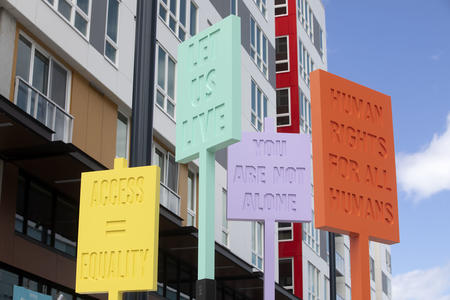But yesterday I visited a new sound sculpture that, along with the merciful marine layer, had me feeling more geographically rooted. The piece, by Virginia-based sculptor and composer Stephen Vitiello, is called “Land Buoy Bells,” and it’s the first permanent artwork in the city’s massive waterfront park project.
ArtSEA: Notes on Northwest Culture is Crosscut’s weekly arts & culture newsletter.
It sits at the end of the fishing dock next to the recently revamped Pier 62, just north of the Seattle Aquarium, and it looks like a set of giant, shiny frying pans standing up on their handles.
I arrived just moments after the installation was completed, as engineers in safety vests were packing up. Project manager Jason Huff stuck around to give me the lay of the land — which wasn’t land at all, but a gangway leading to a floating dock that wavered on choppy waters. I loosened my knees and set my sea legs.
Stephen Vitiello's "Land Buoy Bells" was just installed as the first of several permanent artworks in Seattle's new waterfront project. This video reveals the mechanics underneath the bells, which operate based on the rise and fall of the floating dock. (Daniel Spils)
“When the ferry comes in, it really affects the artwork,” Huff said. We watched as the waves approached, felt the dock roll and heard the bells ring an industrial chime. When the water is calm, the bells are silent. “The artist wanted to capture the changes in wave action from the tides, the water traffic and the wind,” he said. “Clanggg,” the art added.
The “bells” are five stainless steel tank ends (the largest is 4 feet in diameter). These concave disks are triggered internally by energy captured from the rising and falling dock (see video). Some bells face back at Alaskan Way, others, out toward the Sound, making visible — and audible — the connection we locals experience between land and sea.
“The Seattle waterfront is beautiful and ever-changing — misty, then sunny, then rainy,” Vitiello states on the project website. “It inspired the idea of a piece that would be environmentally played, that would change with the weather and the tides.” Already it seems to fit right in, joining the spontaneous symphony of squawking gulls, ship horns, city bustle and our trademark weather.
The weather in Étretat, France, will be mid-60s and rainy all weekend — a dreamy forecast for Northwest mossbacks but perhaps a bit damp for plein air painters like Claude Monet. The famed French impressionist is the subject of a new show at Seattle Art Museum and, reader, there isn’t a single water lily on the walls.
Monet at Étretat (July 1-Oct. 17) showcases a specific body of paintings Monet made in the 1880s, while staying at a seaside town on the Normandy Coast in the blustery off-season.
Curated by Chiyo Ishikawa, SAM’s former deputy director for art, the small-scale show is built around the only Monet in SAM’s permanent collection: “Fishing Boats at Étretat” (1885). In that painting, red, black and yellow boats are pulled up onto a pink beach; beyond, a turquoise sea crashes and churns.
“I see him identifying with the boats,” Ishikawa told me, as we stood next to the painting this week. Bad weather prevented the fishermen from working and Monet from setting up his easel outdoors. She explained that Monet approached his practice — especially during this period of financial struggle and career frustration — as a daily task, almost a duty to capture the environment accurately in different light and shifting weather conditions.
“He liked the turbulent weather,” Ishikawa said, noting how it offered him fresh views of Étretat’s famous cliffs. “But it made it harder to paint.”
Monet’s letters from this period reflect his vexation at being in his mid-40s and never having had a big breakthrough (it came soon after). His self-doubt is resounding and relatable: “I reviewed my work of these past days and it seems to me that it’s all bad,” he writes.
Personally, I’ve had my fill of Monet’s water lilies (same goes for his haystacks) — especially as reproduced on posters, coffee mugs and puzzles. But this show caught my attention anew, thanks to its humanizing lens. Here we see the man not as the progenitor of mass-produced prettiness, but as a stalwart artist trying to both please a fickle art market and express something true about nature, atmosphere and his home environment.
Weather as national identity is a theme in the newest show at the National Nordic Museum, Among Forests and Lakes: Landscape Masterpieces from the Finnish National Gallery (through Oct. 17). I’d been meaning to visit since the exhibit opened in May, and the idea of cold seas and snowy trees proved irresistible during the heat wave.
The deep blue gallery is instantly cooling, augmented by paintings of chilly scenes: Aimo Kanerva’s abstract wash of white nearly obliterates a grove in “Winter Landscape from Sotkamo” (1949); in Akseli Gallen-Kallela’s “Winter” (1902), evergreen boughs are burdened with snow thick as Cool Whip; and H. Ahtela (aka Einar Reuter, a forester by profession) contributes “Boats Waiting” (1955), in which small craft beached and blanketed in snow resonate with Monet’s scenes from Étretat.
But my favorite piece in the show is the sole video work — a short film by Sámi-Finnish artist Marja Helander called “Birds in the Earth” (2018). It is indeed a “landscape masterpiece,” as it follows two Sámi ballerina twins, Birit and Katja Haarla, as they move gracefully across Arctic lands remote and urban, wearing white tutus and point shoes.
In a behind-the-scenes talk, Helander explains that the filming took place in minus 10 Fahrenheit. You can feel the dancers’ exposed skin reddening as they traverse scrubby moss, barren woods and snowy streets, and there’s a real sense of relief in the brief moments when they appear in traditional Sámi gákti, winter dresses, leggings and boots.
Eventually the ballerinas arrive at the House of Parliament in Helsinki, dancing through the stately columns (accompanied by a taxidermied reindeer). We glimpse them on the grand steps in Sámi garments, moving with looser limbs — a hint at histories obscured, storms of radical displacement. “My film is not a statement or a pamphlet,” Helander says. “There’s humor, music … beautiful views, stuffed animals, adventure, nature.”
Get the latest in local arts and culture
This weekly newsletter brings arts news and cultural events straight to your inbox.










